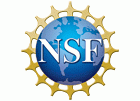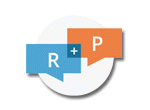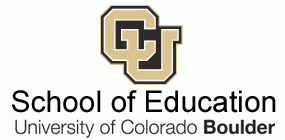Research Brief: The Informal Formative Assessment Cycle as a Model for Teacher Practice
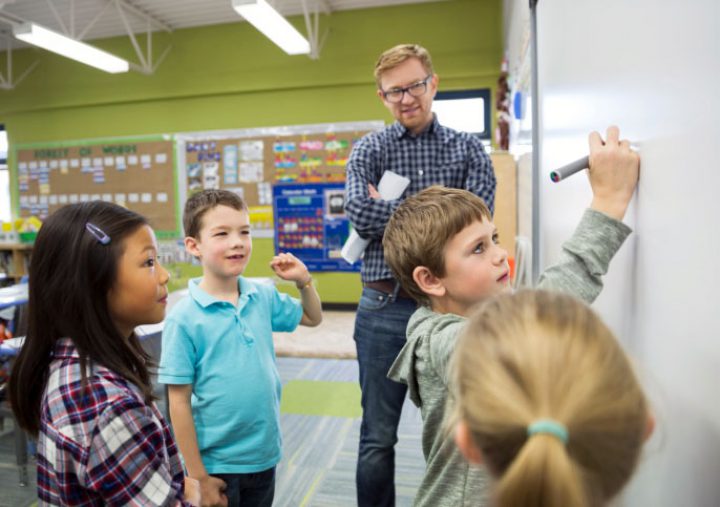
Ruiz-primo, M. A., & Furtak, E. M. (2007). Exploring teachers’ informal formative assessment practices and students’ understanding in the context of scientific inquiry. Journal of Research in Science Teaching, 44(1), 57–84. doi:10.1002/tea.20163
Summary
Informal formative assessment in the classroom takes place when a teacher elicits student thinking and makes immediate use of this knowledge in instruction. In this study, researchers studied three teachers with varying informal assessment practices to explore the nature of informal formative assessment and its connection to student learning.
Authors:
BY VANESSA DE LEON & ANNIE ALLEN - MAY 2015
Theoretical Background
Formative assessment (FA) refers to assessment for learning rather than assessment of learning, allowing teachers to use knowledge of student understandings to inform their ongoing instruction (Black, 1993). Ruiz- Primo and Furtak claim that formative assessments can be seen as falling on a continuum from formal to informal. They define informal formative assessments as ongoing strategies that help teachers acquire information from students that can immediately be used in instruction. In the table below (adapted from p. 60 in their paper), the authors usefully distinguish informal and formal formative assessment strategies.
The authors offer a model of “assessment conversation” (Duschl & Gitomer, 1997) in which teachers elicit, recognize, and use student thinking and engagement during instruction. They identify four parts of this informal formative assessment cycle, which they call an “ESRU Cycle”.
- Teacher Elicits Response
- Student Responds
- Teacher Recognizes Student Response
- Teacher Uses Student Response
Differences Between Formal and Informal Formative Assessment Practices
Formal: Designed to provide evidence about students’ learning
|
Gathering |
Interpreting |
Acting |
|---|---|---|
| Teacher Collects or brings together information from students at a planned time |
Teacher takes time to analyze information collected from students |
Teacher plans an action to help students achieve learning goals |
| Example: giving quizzes or embedded assignments |
Example: reading student work and providing written comments to all students |
Example: writing or changing lesson plans to address the state of student learning |
Informal: Evidence of learning generated during daily activities
|
Eliciting |
Recognizing |
Using |
|---|---|---|
|
Teacher brings out or develops information in the form of a verbal response from students |
Teacher reacts on the fly by recognizing students’ responses and comparing them to accepted scientific ideas |
Teacher immediately makes use of information from the students during the course of the ongoing classroom narrative |
|
Example: asking students to formulate explanations or to provide evidence |
Example: repeating or revoicing students’ responses |
Example: asking students to elaborate on their responses, explaining learning goals, promoting argumentation |
Research Design
Using the “assessment conversation” model, the authors set out to address two research questions: (1) Can this model help to distinguish the quality of informal assessment practices across teachers? (2) Can the quality of teachers’ informal formative assessment practices be linked to student performance? The authors studied the classroom assessment conversations of three 6th/7th grade science teachers. Teachers video recorded lessons they taught in a physical sciences unit using an inquiry-based curriculum, Foundational Approaches to Science Teaching (FAST).
The authors analyzed informal classroom assessment conversations to see how they fit with the ESRU cycle (Elicit, Student Response, Recognize, Use). Additionally, the researchers measured student learning with a multiple choice pre-test and a 38- item multiple-choice test after the investigation was completed. Researchers concluded that teachers who had whole-class conversations that were more consistent with the ESRU cycle had higher learning gains for students. Notably, it was the final step of the cycle (Use) that was vital for gains to be made.
Classroom Example of an Informal Assessment Conversation
This transcript is excerpted from Danielle’s class shown in Table 7 in Ruiz-Primo & Furtak, 2007, p. 73:
1. Danielle: So the first three things you want to do, very important things, you want to label your vertical axis, you want to label your horizontal axis, and then you want to give the whole graph a title. And we’ve done that.
2. So, taking a look at this, am I ready to go? Can I start plotting my points?
3. Student: No.
4. Danielle: Why not?
5. Student: You didn’t…
6. Danielle: What do we need to do? Eric?
7. Student: Put the scale.
8. Danielle: The scales. What do you mean by scales?
9. Student: The numbers.
10. Danielle: “The numbers.” Good. Excellent. I liked that you used the word “scales,” it’s a very scientific word. So, yes, we need to figure out what the scales are, what we should number the different axes.
Reflection Questions
- Read and reflect on this transcript from Danielle’s classroom from Ruiz-Primo & Furtak’s article. Where do you see the steps of the ESRU cycle in action? What is each step accomplishing for the teacher and for the students?
- What examples of this kind of formative assessment can you think of from your own or others’ classroom practice? Which aspects of the ESRU cycle are easier and which are more challenging to accomplish?
- What strategies do you use to give voice to all students in these kinds of informal assessment conversations?
- What supports do teachers need to enact robust informal formative assessment in their classrooms?

Implications for Practice
For teachers: We suggest that less attention be paid to rote procedures in the science classroom, and more attention be paid to knowledge generation in order for students to fully experience scientific inquiry. Further, we suggest that instructional responsiveness—i.e., teachers' ability to take students' ideas and use them to inform instruction and guide learning based on their existing understandings—is essential.
For teacher education and professional development: We suggest that content knowledge alone is not enough to conduct informal formative assessment. Rather, attention to the stages of the ESRU cycle is vital. Additionally, being explicit with pre- and in-service teachers about the differences in a ESRU model versus a traditional IRE/F model (Teacher Initiation, Student Response, Teacher Evaluation/Feedback) of classroom discussion is important for eliciting information to improve student learning. As a result, it is imperative that teachers are provided with the tools necessary to integrate assessment into the course of daily instruction to enact inquiry-based reforms.
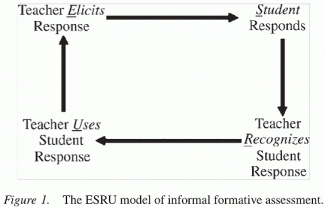
Related Briefs
- Bevan, B. (2011). Classroom talk, participation, and learning: Is all talk good talk?: An ISE research brief discussing Atwood et al.'s, "The construction of knowledge in classroom talk."
- Stromholt, S. (2011). Questioning strategies to deepen scientific thinking: An ISE brief discussing Oliveira's, "Improving teacher questioning in science inquiry discussions through professional development."
Related Research
- Black, P. (1993). Formative and summative assessment by teachers. Studies in Science Education, 21, 49-97.
- Duschl, R.A., & Gitomer, D.H. 1997. Strategies and challenges to changing the focus of assessment and instruction in science classrooms. Educational Assessment, 4, 37-73.
Attending to Equity
- Formative assessment practices gives students chances to get meaningful feedback in a low-stakes environment, which supports their learning and helps them develop confidence in their ability to express their understanding.
- Give voice to all students in order to fully engage students in inquiry-based lessons and effectively implement informal formative assessment practices with them.
- Welcome and integrate students’ own experiences as part of the learning environment and development of knowledge.
ALSO SEE STEM TEACHING TOOLS
STEM Teaching Tools content copyright 2014-22 UW Institute for Science + Math Education. All rights reserved.
This site is primarily funded by the National Science Foundation (NSF) through Award #1920249 (previously through Awards #1238253 and #1854059). Opinions expressed are not those of any funding agency.
Work is licensed under a Creative Commons Attribution-ShareAlike 4.0 Unported License. Others may adapt with attribution. Funded by the National Science Foundation (NSF). Opinions expressed are not those of any funding agency.


 Email Feedback
Email Feedback
